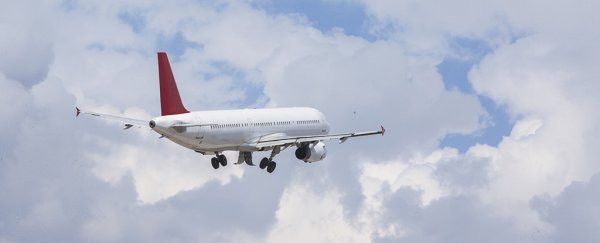Airplanes often receive a speed increase from air currents high in the skies, but very few get an insane boost like this: helped by a tailwind of more than 322 km (200 miles) per hour, a Boeing 787-9 jet reached a ground speed of 1,289 km (801 miles) per hour on Monday night.
The top speed was recorded by the Virgin Atlantic commercial flight from LA to London while over central Pennsylvania, at somewhere around 10,670 metres (35,000 feet) above ground.
"Never ever seen this kind of tailwind in my life as a commercial pilot!!" tweeted Peter James, a commercial pilot.
Almost 800 mph now never ever seen this kind of tailwind in my life as a commercial pilot !! (200 mph tailwind ) pic.twitter.com/0XGTkEP9EB
— PilotPete🛩️👨✈️ (@jetpeter1) February 19, 2019
That's above the speed of sound (1,234 km or 767 miles per hour at sea level in normal conditions), but there was no sonic boom. Because the airplane was being ferried along in a stream of fast moving air, the airplane was only travelling at somewhere near its usual cruising speed in relation to the air around it.
Thanks to the jet stream buffer, the flight landed at London Heathrow 48 minutes early.
Jet streams are caused by circulating air high up in the atmosphere, due to differences in temperature between different air masses. The main jet streams move from west to east, benefitting planes going in that direction but counting against them when they're coming the other way.
Flight times can often be affected, but you'll usually find they're well accounted for in airline timetables… until, that is, a particularly strong jet stream comes along.
The top jet stream speed logged above New York on Monday evening was 372 km (231 miles) per hour, breaking the previous record of 359 km (223 miles) per hour. Whether or not the plane's ground speed is a record isn't certain though, as it's not something Boeing keeps logs of.
What we do know is a Boeing 787-9 plane hit a top ground speed of 1,249 km (776 miles) per hour in 2018, thanks to some atmospheric help. It went from New York to London in 5 hours, 13 minutes – a record for a plane that's not a Concorde (which could do the trip in less than 3 hours).
This latest super-strong jet stream is actually three jet streams in one, each propelled along by particularly extreme weather conditions – and therefore particularly extreme contrasts between warmer and colder air.
The conditions responsible include warming seas near the equator (the El Niño effect), twin cyclones in the Pacific, and the cold polar vortex pushing down from the Arctic, transforming already strong winds into record-breaking ones.
It's something to look out for on your in-flight information display, the next time you're crossing the Atlantic in a plane.
"A 100 mph [161 km/h] increase in the jet stream above typical can add or remove about an hour from a 5 to 6 hour flight," a spokesperson for global aviation tracking service FlightAware told CBS News.
